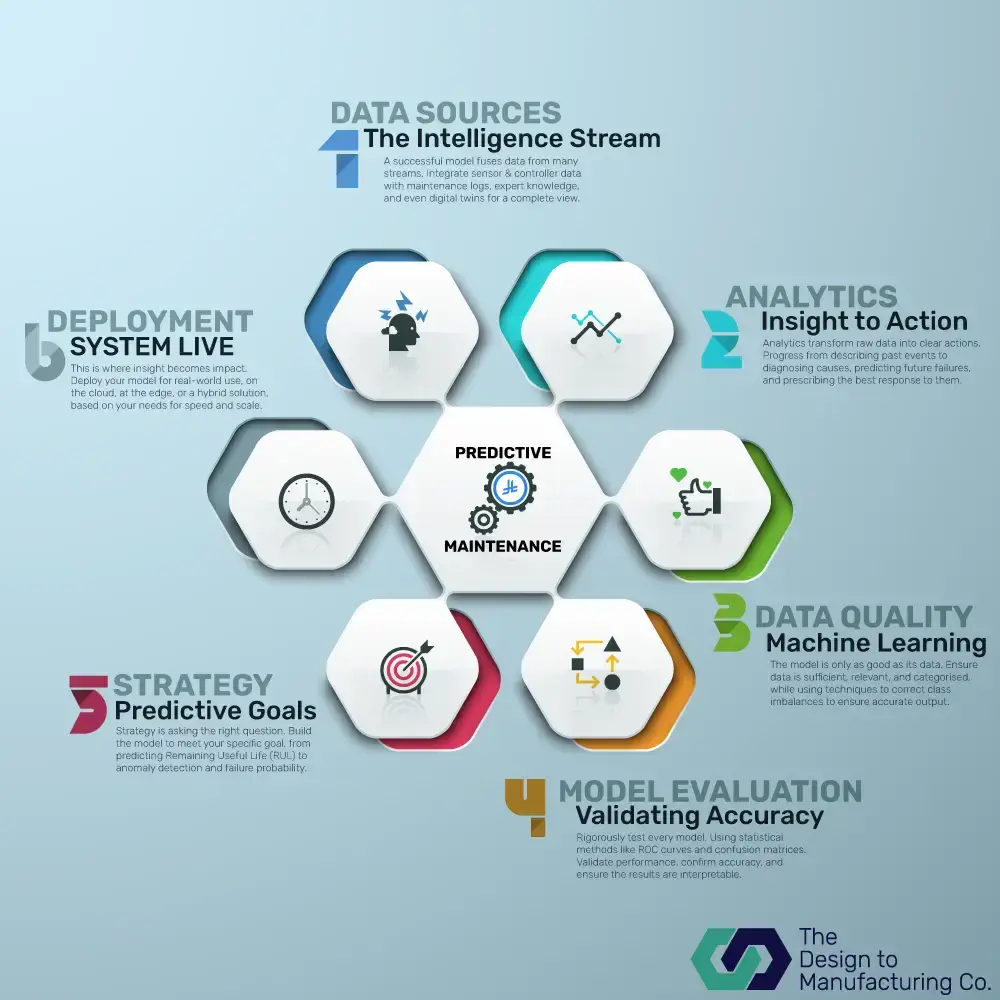In the rapidly evolving industrial landscapes of the UAE and Saudi Arabia, operational efficiency, asset longevity, and uptime are not just goals – they are critical competitive advantages.
For sectors as demanding as Aerospace, Defense, and Energy, Process & Utilities (including vital oil & gas and pipeline operations), the shift from reactive to proactive maintenance is paramount. Predictive Maintenance (PdM), powered by advanced analytics, stands as the cornerstone of this transformation, promising unprecedented insights and significant ROI.
This article, for leaders and technical decision-makers in the region, dissects the core analytical considerations vital for successful Predictive Maintenance implementation, ensuring assets continue to perform optimally in even the most challenging environments.
However, successfully navigating the diverse technologies and data strategies discussed is a significant undertaking. Recognizing that no single platform can deliver a complete solution, The Design to Manufacturing Co. provides the cross-disciplinary expertise necessary to design and implement a truly effective predictive maintenance program.
Data Sources: The Foundation of Foresight
The efficacy of any PdM program hinges on the quality and breadth of its data inputs. A robust strategy incorporates diverse data streams, ensuring a comprehensive view of asset health.
Knowledge-Based Data
This category leverages existing institutional knowledge and established benchmarks.
- Pre-built models: Off-the-shelf or industry-standard analytical models provide a rapid starting point, incorporating established failure modes and performance curves relevant to specific equipment types in aerospace engines or refinery pumps.
- ‘First principles’ data: Physics-based models derived from fundamental engineering principles (e.g., thermodynamics, fluid dynamics) offer deep insights into component behavior, crucial for designing durable defence systems or optimizing complex energy infrastructure.
- Subject-matter expertise: The invaluable insights of seasoned engineers and technicians, often codified into rules or algorithms, capture nuances unique to specific operational contexts, such as an oil rig in harsh desert conditions or an aircraft fleet operating in high temperatures.
- Maintenance logs / feedback: Historical records of repairs, inspections, and reported issues provide a critical retrospective view, highlighting recurring problems and informing future predictions for critical pipeline segments or defence hardware.
Hardware-Based Data
Direct measurements from equipment form the bedrock of real-time predictive analytics.
- Asset data: Comprehensive information about the asset itself, including manufacturer specifications, model numbers, installation dates, and operational history, essential for tracking the lifecycle of an aircraft component or a gas turbine.
- Retrofit sensor data: For existing infrastructure, adding new sensors (e.g., vibration, temperature, acoustic) allows for data collection from previously unmonitored points, providing vital signs for aging pipeline networks or legacy defence systems.
- Controller data: Data from Programmable Logic Controllers (PLCs) and Distributed Control Systems (DCS) offers a granular view of machine operation, critical for understanding the state of processing units in energy plants.
- Gateway data: Aggregates and transmits data from various sensors and controllers to central analytics platforms, bridging the operational technology (OT) and information technology (IT) divide for seamless data flow from remote defence sites or offshore platforms.
External/Other Data
Augmenting internal data with external information provides richer context.
- Process and historian data: Long-term historical operational data provides context for performance trends, helping to understand how an asset behaves over its entire operational lifetime under varying loads in a refinery or power plant.
- Synthetic data through digital twins: High-fidelity simulations and digital twins generate realistic operational data under various conditions, enabling predictive modeling for scenarios difficult or dangerous to test in the real world, such as extreme stress on aircraft structures or pipeline integrity under seismic activity.
Types of Analytics: From Description to Automation
The journey of predictive maintenance analytics progresses through different levels of sophistication, each offering deeper insights and more automated actions.
- Descriptive: “What happened?” – Understanding past events and performance, such as recent equipment failures or maintenance activities.
- Diagnostic: “Why did it happen?” – Identifying the root causes of issues, crucial for preventing recurrence in sensitive defence equipment or high-pressure energy systems.
- Predictive: “What will happen?” – Forecasting future events, such as potential equipment failure, enabling proactive scheduling of maintenance for critical assets like gas compressors or fighter jets.
- Prescriptive: “What should we do?” – Recommending specific actions to optimize performance or prevent failure, moving towards decision support and ultimately, decision automation.
Data Requirements: Ensuring Analytical Rigor
For analytics to be reliable, the underlying data must meet specific criteria.
Relevancy
- Error history: Comprehensive records of past failures are vital for training models to predict similar future events in complex machinery.
- Machine operating conditions: Data on temperature, pressure, load, and other environmental factors provides context for asset performance in harsh desert or offshore conditions.
- Equipment metadata: Detailed specifications, maintenance schedules, and component history enrich predictive models.
Sufficiency
- Event frequency: Adequate occurrences of failure events are needed for models to learn patterns accurately, especially for rare but critical failures in aerospace components.
- Sensor coverage: Sufficient sensor deployment ensures that all critical parameters affecting asset health are monitored, preventing blind spots in pipeline monitoring or defence system diagnostics.
- Timestamp accuracy: Precise time-stamped data is essential for correlating events and establishing causal relationships.
- Ability to match data sets: The capability to integrate and align disparate data sources ensures a holistic view of asset health.
Model Evaluation: Validating Predictive Power
Once models are built, rigorous evaluation is critical to ensure their accuracy and reliability.
- Model diagnostics: Assessing the internal workings and performance of the model itself.
- Performance methods: Quantifying how well the model predicts outcomes.
- ROC curve and AUC: Measures the model’s ability to distinguish between healthy and faulty states.
- Precision-recall curve: Particularly useful for imbalanced datasets (where failures are rare), highlighting the model’s ability to correctly identify positive cases.
- Interpretability & insights: Understanding why the model makes certain predictions, building trust, and facilitating actionable insights for engineers.
- Error & statistical analysis: Identifying sources of error and the statistical significance of predictions.
- Confusion matrix: Provides a breakdown of correct and incorrect classifications (true positives, false positives, true negatives, false negatives).
- Statistical testing: Validates the hypotheses and assumptions underlying the model.
Modeling Strategy: Defining the Predictive Approach
The choice of modeling strategy dictates the type of insights gained.
- Remaining Useful Life (RUL): Predicting the time until an asset or component is expected to fail, allowing for optimal maintenance scheduling.
- Probability of failure within a time window: Assessing the likelihood of failure within a specific future period, useful for risk assessment in critical infrastructure like pipelines or defence systems.
- Anomaly detection: Identifying deviations from normal operating behavior that could indicate impending issues, critical for early warning in complex machinery.
- Survival analysis: Modeling the time to an event (e.g., failure) and the factors influencing it, providing deeper insights into asset longevity.
Model Deployment: Operationalizing Insights
Bringing predictive models from development to live operation is crucial for realizing their value.
- Cloud implementation: Leveraging scalable cloud infrastructure for complex computations and large datasets, offering flexibility and cost-efficiency for diverse operations.
- Edge implementation: Deploying models directly on devices or gateways closer to the data source, enabling real-time predictions and actions without constant cloud connectivity, ideal for remote oil & gas sites or defence outposts.
- Hybrid implementation: Combining cloud and edge capabilities for optimized performance, balancing computational power with low-latency requirements.
Decision Factors for Deployment
- Latency: How quickly predictions are needed (e.g., immediate for critical events vs. daily for scheduling).
- Data size: The volume of data being processed.
- Data quality: The reliability and cleanliness of the data.
- Decision time: The timeframe within which an intervention can be made.
Class Imbalances: Addressing Data Challenges
In many real-world scenarios, particularly predictive maintenance, failure events are rare, leading to imbalanced datasets. Addressing this is critical for accurate modeling.
Data Processing Methods
- Data level: Techniques applied directly to the training data.
- Sampling: Oversampling the minority class (failures) or undersampling the majority class (normal operations) to balance the dataset.
- Feature selection: Identifying and utilizing the most relevant data attributes.
- Hybrid (SMOTE): Synthetic Minority Over-sampling Technique generates synthetic samples for the minority class, providing a more balanced representation without simply duplicating existing data.
- Algorithm level: Adjusting the learning algorithm itself to account for imbalances.
- Cost-sensitive learning: Assigning different misclassification costs to different classes, penalizing incorrect predictions of rare events more heavily.
- Ensemble level: Combining multiple models to improve performance.
- Data sampling integration: Integrating sampling techniques within ensemble methods.
- Cost-sensitive integration: Applying cost-sensitive learning principles to ensemble models.
The Importance of Partnership
The journey from data acquisition to automated, prescriptive actions involve a complex interplay of technologies, data science, and domain-specific knowledge. It has become clear that no single platform or off-the-shelf technology can address the unique challenges of every industrial environment.
The successful implementation of predictive maintenance hinges on integrating disparate data sources, selecting appropriate modelling strategies, and deploying them in a way that aligns with specific operational realities.
This is where the importance of working with an experienced partner becomes evident. The Design to Manufacturing Co. are well-versed experts in assisting businesses through this journey.
We specialize in architecting holistic predictive maintenance solutions that are technology-agnostic, ensuring your business leverages the best combination of tools and strategies to achieve its asset management goals.
A Strategic Leap Forward
For the Aerospace, Defence, and Energy, Process & Utilities sectors in the UAE and Saudi Arabia, embracing advanced analytics for Predictive Maintenance is no longer optional. It’s a strategic necessity that promises enhanced safety, optimized operational costs, extended asset life, and improved overall efficiency.
By carefully considering each of these analytical facets – from robust data sourcing to sophisticated model deployment and evaluation – organizations can unlock the full potential of their assets, ensuring sustained performance and competitive leadership in a dynamic global economy.
Achieving this strategic leap, however, requires more than just technology; it requires a cohesive strategy. Realizing that no one platform can master the complexities of data integration, model selection, and operational deployment is the first step.
The Design to Manufacturing Co. serves as the essential partner for this journey, offering the deep expertise needed to assist in your business’s predictive maintenance implementation and turn analytical potential into tangible results.


